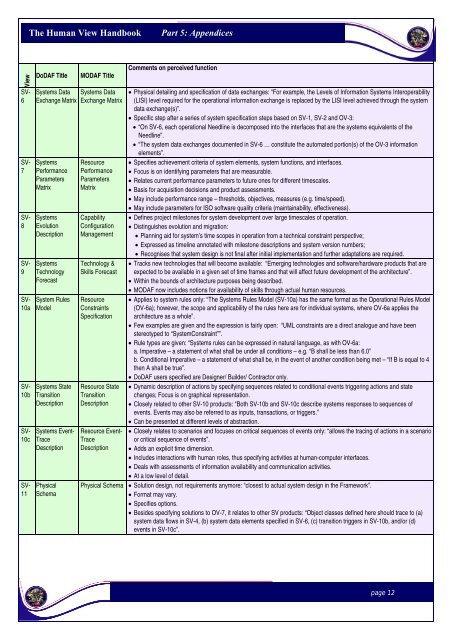The Human View Handbook for MODAF: Part V â Appendices
The Human View Handbook for MODAF: Part V â Appendices
The Human View Handbook for MODAF: Part V â Appendices
Create successful ePaper yourself
Turn your PDF publications into a flip-book with our unique Google optimized e-Paper software.
<strong>The</strong> <strong>Human</strong> <strong>View</strong> <strong>Handbook</strong><br />
<strong>Part</strong> 5: <strong>Appendices</strong><br />
<strong>View</strong><br />
SV-<br />
6<br />
SV-<br />
7<br />
SV-<br />
8<br />
SV-<br />
9<br />
SV-<br />
10a<br />
SV-<br />
10b<br />
SV-<br />
10c<br />
SV-<br />
11<br />
DoDAF Title<br />
Systems Data<br />
Exchange Matrix<br />
Systems<br />
Per<strong>for</strong>mance<br />
Parameters<br />
Matrix<br />
Systems<br />
Evolution<br />
Description<br />
Systems<br />
Technology<br />
Forecast<br />
System Rules<br />
Model<br />
Systems State<br />
Transition<br />
Description<br />
Systems Event-<br />
Trace<br />
Description<br />
Physical<br />
Schema<br />
<strong>MODAF</strong> Title<br />
Systems Data<br />
Exchange Matrix<br />
Resource<br />
Per<strong>for</strong>mance<br />
Parameters<br />
Matrix<br />
Capability<br />
Configuration<br />
Management<br />
Technology &<br />
Skills Forecast<br />
Resource<br />
Constraints<br />
Specification<br />
Resource State<br />
Transition<br />
Description<br />
Resource Event-<br />
Trace<br />
Description<br />
Comments on perceived function<br />
• Physical detailing and specification of data exchanges: “For example, the Levels of In<strong>for</strong>mation Systems Interoperability<br />
(LISI) level required <strong>for</strong> the operational in<strong>for</strong>mation exchange is replaced by the LISI level achieved through the system<br />
data exchange(s)”.<br />
• Specific step after a series of system specification steps based on SV-1, SV-2 and OV-3:<br />
• “On SV-6, each operational Needline is decomposed into the interfaces that are the systems equivalents of the<br />
Needline”.<br />
• “<strong>The</strong> system data exchanges documented in SV-6 … constitute the automated portion(s) of the OV-3 in<strong>for</strong>mation<br />
elements”.<br />
• Specifies achievement criteria of system elements, system functions, and interfaces.<br />
• Focus is on identifying parameters that are measurable.<br />
• Relates current per<strong>for</strong>mance parameters to future ones <strong>for</strong> different timescales.<br />
• Basis <strong>for</strong> acquisition decisions and product assessments.<br />
• May include per<strong>for</strong>mance range – thresholds, objectives, measures (e.g. time/speed).<br />
• May include parameters <strong>for</strong> ISO software quality criteria (maintainability, effectiveness).<br />
• Defines project milestones <strong>for</strong> system development over large timescales of operation.<br />
• Distinguishes evolution and migration:<br />
• Planning aid <strong>for</strong> system’s time scopes in operation from a technical constraint perspective;<br />
• Expressed as timeline annotated with milestone descriptions and system version numbers;<br />
• Recognises that system design is not final after initial implementation and further adaptations are required.<br />
• Tracks new technologies that will become available: “Emerging technologies and software/hardware products that are<br />
expected to be available in a given set of time frames and that will affect future development of the architecture”.<br />
• Within the bounds of architecture purposes being described.<br />
• <strong>MODAF</strong> now includes notions <strong>for</strong> availability of skills through actual human resources.<br />
• Applies to system rules only: “<strong>The</strong> Systems Rules Model (SV-10a) has the same <strong>for</strong>mat as the Operational Rules Model<br />
(OV-6a); however, the scope and applicability of the rules here are <strong>for</strong> individual systems, where OV-6a applies the<br />
architecture as a whole”.<br />
• Few examples are given and the expression is fairly open: “UML constraints are a direct analogue and have been<br />
stereotyped to “SystemConstraint””.<br />
• Rule types are given: “Systems rules can be expressed in natural language, as with OV-6a:<br />
a. Imperative – a statement of what shall be under all conditions – e.g. “B shall be less than 6.0”<br />
b. Conditional Imperative – a statement of what shall be, in the event of another condition being met – “If B is equal to 4<br />
then A shall be true”.<br />
• DoDAF users specified are Designer/ Builder/ Contractor only.<br />
• Dynamic description of actions by specifying sequences related to conditional events triggering actions and state<br />
changes; Focus is on graphical representation.<br />
• Closely related to other SV-10 products: “Both SV-10b and SV-10c describe systems responses to sequences of<br />
events. Events may also be referred to as inputs, transactions, or triggers.”<br />
• Can be presented at different levels of abstraction.<br />
• Closely relates to scenarios and focuses on critical sequences of events only: “allows the tracing of actions in a scenario<br />
or critical sequence of events”.<br />
• Adds an explicit time dimension.<br />
• Includes interactions with human roles, thus specifying activities at human-computer interfaces.<br />
• Deals with assessments of in<strong>for</strong>mation availability and communication activities.<br />
• At a low level of detail.<br />
Physical Schema • Solution design, not requirements anymore: “closest to actual system design in the Framework”.<br />
• Format may vary.<br />
• Specifies options.<br />
• Besides specifying solutions to OV-7, it relates to other SV products: “Object classes defined here should trace to (a)<br />
system data flows in SV-4, (b) system data elements specified in SV-6, (c) transition triggers in SV-10b, and/or (d)<br />
events in SV-10c”.<br />
page 12
















